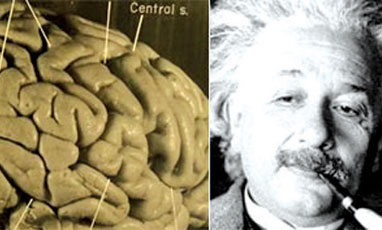Einstein's brain reveals clues to genius
Einstein's brain had extraordinary folding patterns in several
regions, which may help explain his genius, newly uncovered photographs
suggest.
The photographs, published on November 16 in the journal Brain,
reveal that the brilliant physicist had extra folding in his brain's
gray matter, the site of conscious thinking. In particular, the frontal
lobes, regions tied to abstract thought and planning, had unusually
elaborate folding, analysis suggests.
 "It's a really sophisticated part of the human brain," said Dean
Falk, study co-author and an anthropologist at Florida State University,
referring to gray matter. "And [Einstein's] is extraordinary." "It's a really sophisticated part of the human brain," said Dean
Falk, study co-author and an anthropologist at Florida State University,
referring to gray matter. "And [Einstein's] is extraordinary."
Snapshots of a genius Albert Einstein was the most famous physicist
of the 20th century; his groundbreaking theory of general relativity
explained how light curves due to the warping of space-time.
When the scientist died in 1955 at age 76, Thomas Harvey, the
pathologist who autopsied him, took out Einstein's brain and kept it.
Harvey sliced hundreds of thin sections of brain tissue to place on
microscope slides and also took 14 photographs of the brain from several
angles. Harvey presented some of the slides, but kept the photos secret
in order to write a book about the physicist's brain.
The pathologist died before finishing his book, however, and the
photos remained hidden for decades. But in 2010, after striking up a
friendship with one of the new study's co-authors, Harvey's family
donated the photos to the National Museum of Health and Medicine in
Washington, D.C. Falk's team began analysing the photographs in 2011.
More brainy connections
The team found that, overall, Eintsein's brain had much more
complicated folding across the cerebral cortex, which is the gray matter
on the surface of the brain responsible for conscious thought.
In general, thicker gray matter is tied to higher IQs. Many
scientists believe that more folds can create extra surface area for
mental processing, allowing more connections between brain cells, Falk
said.
With more connections between distant parts of the brain, one would
be able to make, in a sense, mental leaps, drawing upon these faraway
brain cells to solve some cognitive problem.
The prefrontal cortex, which plays a key role in abstract thought,
making predictions and planning, also had an unusually elaborate folding
pattern in Einstein's brain. That may have helped the physicist develop
the theory of relativity. "He did thought experiments where he'd imagine
himself riding alongside a beam of light, and this is exactly the part
of the brain one would expect to be very active" in such thought
experiments, Falk told LiveScience. In addition, Einstein's occipital
lobes, which perform visual processing, showed extra folds and creases.
The right and left parietal lobes also looked very asymmetrical, Falk
said. It's not clear how those features contributed to Einstein's
genius, but that brain region is key for spatial tasks and mathematical
reasoning, Falk said.
The jury is still out on whether Einstein's brain was extraordinary
from birth or whether years of pondering physics made it special. Falk
believes both played a role.
"It was both nature and nurture," she said.
"He was born with a very good brain, and he had the kinds of
experiences that allowed him to develop the potential he had."
But most of Einstein's raw ability probably came from a trick of
nature rather than a lifetime of hard work, said Sandra Witelson, of the
Michael G. De Groot School of Medicine at McMasters University who has
done past studies of Einstein's brain. In 1999, her work revealed that
Einstein's right parietal lobe had an extra fold, something that was
either hardwired into his genes or happened while Einstein was still in
the womb.
"It's not just that it's bigger or smaller, it's that the actual
pattern is different," Witselson said.
"His anatomy is unique compared to every other photograph or drawing
of a human brain that has ever been recorded."
- Livescience
|



